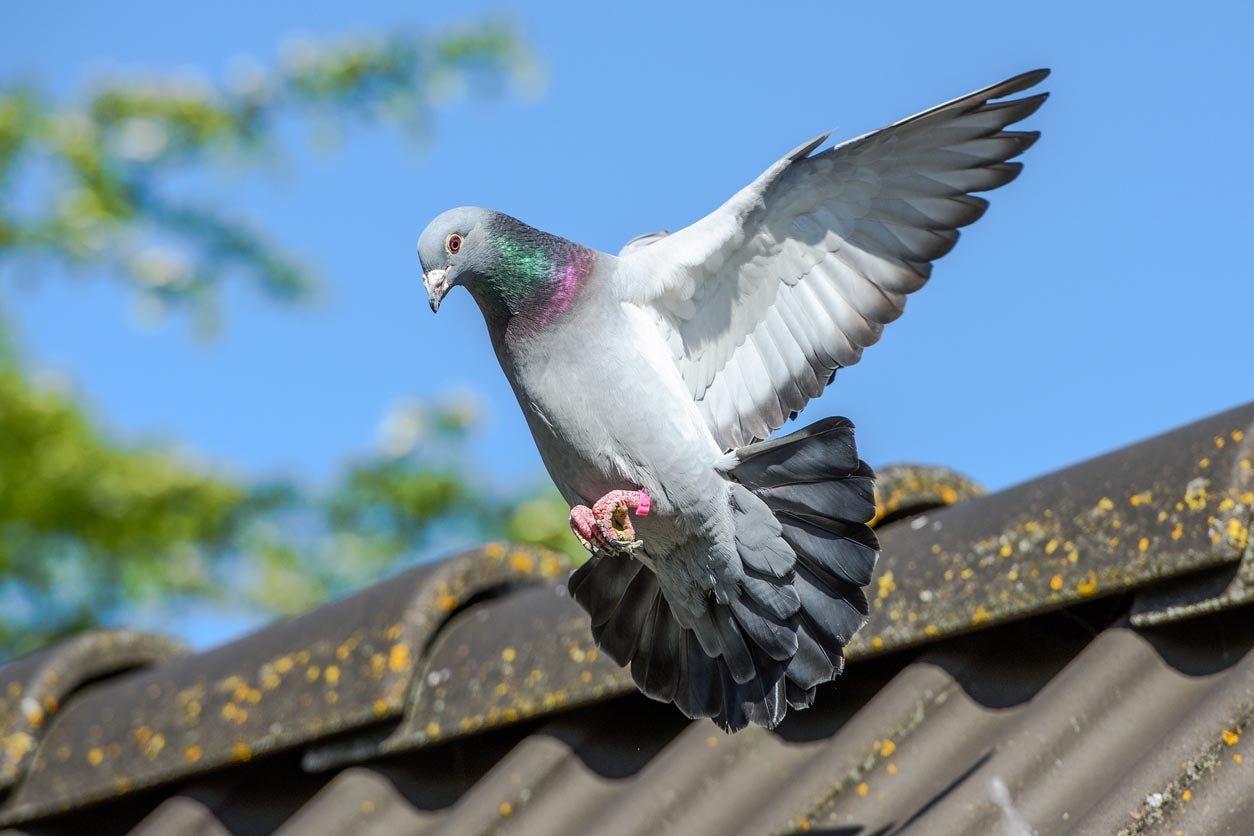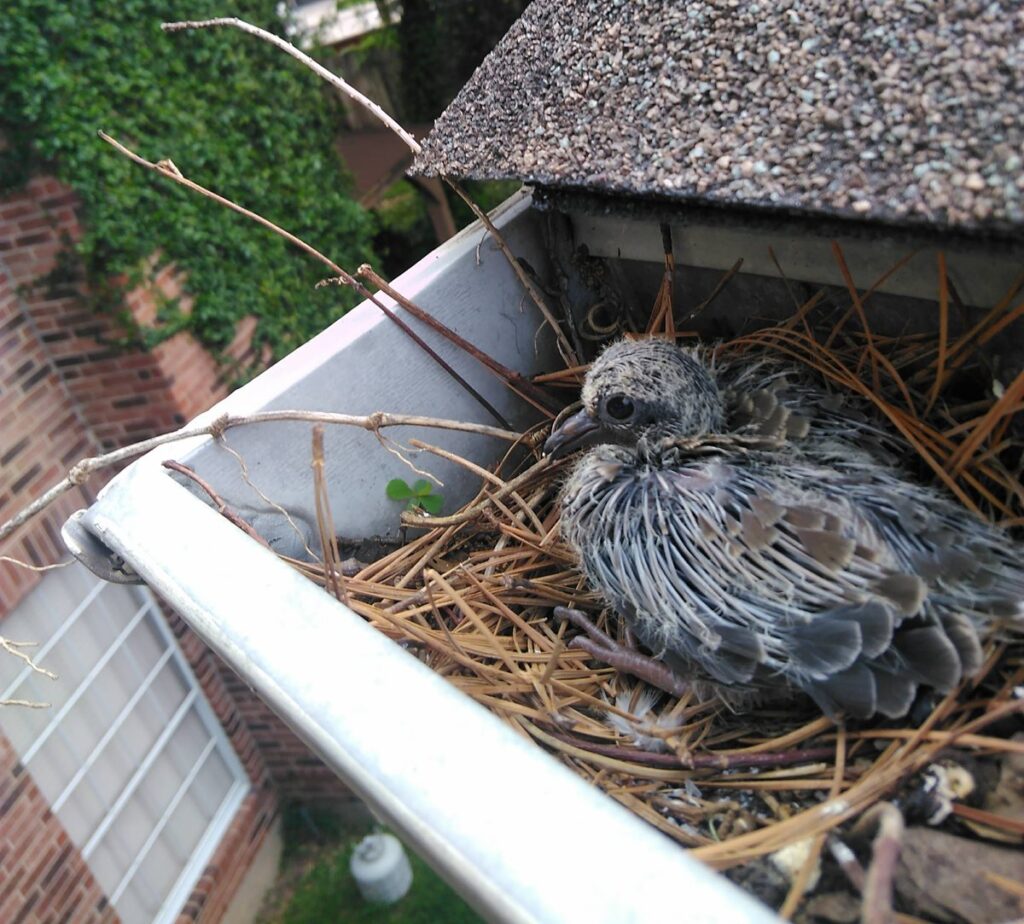
Fast, Reliable, Safe Bird Control for Homes and Businesses
We don’t usually think of birds as pests, but if you have birds that have flown into your home or are nesting or roosting on your property, they can become a serious problem that requires bird control. Flocks of birds create a hazard with their droppings, damage your roof and siding, and can rob your trees of fruit.
People have trusted Critter Control to safely and legally solve their bird problems, whether residential or commercial property.
Signs You Have a Pest Bird Problem

- Bird Dropping Accumulation
- Nesting Materials in Gutters, Vents, Signs, or Rooftops
- Birds Nesting Inside or along Rooflines, Signs, Gutters.
- Loud, Persistent Noises
- Property Damage
- Foul Odors
How Birds Can Damage Your Property

While birds may seem harmless at first glance, a bird infestation can lead to serious structural, health, and financial problems. Here’s how:
- Structural Damage
-
- Acidic Droppings: Bird droppings contain uric acid, which corrodes metal, concrete, stone, paint, and roofing materials. Over time, this can weaken building structures and lead to expensive repairs.
- Nesting in Vents and Gutters: Birds often nest in gutters, vents, and chimneys, blocking airflow, causing water backup, and creating fire hazards.
- Roof Damage: Birds can dislodge roofing tiles or shingles while nesting or roosting, allowing moisture to penetrate the structure.
- Solar Panel Interference: Pigeons and other birds nesting under solar panels can cause overheating, reduced efficiency, and costly maintenance.
- Health Hazards
-
- Disease Transmission: Birds can carry more than 60 diseases that are transmittable to humans, including histoplasmosis, salmonella, and cryptococcosis.
- Parasites: Bird nests often harbor mites, lice, fleas, and ticks, which can spread to people and pets.
- Contaminated Air: Dried bird droppings can become airborne dust, especially near HVAC intakes, creating respiratory risks.
- Equipment and Utility Damage
-
- HVAC Systems: Birds nesting in or near air conditioning units or exhaust fans can clog filters and vents, reduce efficiency, and cause equipment failure.
- Electrical Hazards: Birds pecking at wires or nesting near transformers can cause shorts, fires, or power outages.
- Property Aesthetics and Value
-
- Foul Odors and Unsightly Messes: Large amounts of droppings and debris smell bad and leave a poor impression on visitors or customers.
- Stained Siding and Windows: Droppings and nesting materials can stain or damage exterior finishes, diminishing curb appeal.
- Noise Pollution: Persistent chirping, squawking, or fluttering can disturb occupants and affect quality of life.
Common Pest Bird Types
There are a handful of bird species that are commonly considered nuisances:
- European Starlings gather in large flocks. Not only do starlings create noise and messes, but they also compete with native birds for nesting sites and food.
- Canada Geese are large birds that can land in large numbers and rest before continuing with their migration. Unfortunately, their droppings create a mess, and they are aggressive.
- Pigeons are common nuisance birds in more urban areas where they roost in large numbers on buildings.
- House Sparrows are small but build nests in your vents and eaves and take over bird feeders.
- Crows are intelligent birds with a loud call. Once they find a consistent food source, they call in their friends.
How Do We Get Rid of Birds
Our licensed bird removal professionals follow a proven process to eliminate raccoons and prevent future invasions:
- Inspection & Identification
We find nests, entry points, and signs of activities. - Humane Bird Removal
Safe, effective, and compliant with wildlife laws. - Exclusions & Prevention
Sealing entry points to prevent re-entry. - Remediation & Repair
Cleaning up after the birds and repairing the damage.
Why Choose Critter Control?
40+ Years of Bird Control Expertise
☑Licenses & Insured Wildlife Removal Professionals
☑Safe, Humane, & Environmentally Responsible Methods
☑100% Customer Satisfaction Guarantee
Bird Control Near You!
Birds in your house vents or gutters? Are flocks of birds roosting on your property or inside your business? Birds can cause significant damage and introduce health risks.
Need Fast Bird Removal?
Call 1-800-274-8837 for Immediate Bird Removal Services
Find Service in your Area:
Get them out.
Keep them out.®
Experiencing a wildlife or pest issue? We can help! Complete this form and your local Critter Control® office will contact you to assist.
Many species of birds are protected by laws because of the important role they play in our environment. Birds are vital for pollination, seed dispersal, and insect control. Some of the laws and regulations Critter Control specialists are fully trained in include the Migratory Bird Act and the Endangered Species Act, as well as regulations enacted on the individual state and local levels. In some instances, special permits from state wildlife agencies must be obtained before nests can be safely and humanely removed.
Birds are a more serious nuisance than most people understand. Nests built inside vents and chimneys can become a fire hazard. Pigeon droppings on sidewalks are slippery, leading to potential fall injuries. These droppings are also corrosive. They contain high levels of uric acid, which damages siding, paint, brickwork, concrete, and even metals.
Birds carry parasites such as fleas, lice, mites, and ticks. Their droppings contain pathogens and fungi that can spread to people and pets and cause diseases, including salmonella and histoplasmosis. Exposure to dried droppings, feathers, and nesting materials can cause allergic reactions and respiratory issues.
If you have a single nest of birds in a vent or roof gutter, Critter Control can remove it if laws permit.
In rescue situations, such as chimneys or basements, birds can be released on-site if the entrance has been secured properly. Occasionally, live traps will be used, especially if flocks of birds are involved. For persistent birds and larger flocks, several advanced techniques may be applied simultaneously, including spikes, mylar tape, scare tactics, and more.
Once the bird or nest has been successfully removed, Critter Control wildlife technicians will seal openings and apply caps on vents or chimneys where necessary. Critter control agents will clean any bird messes and apply sanitization agents to ensure the safety of the home.
For exterior areas, such as roofs and trees, any combination of habitat modification, exclusion tactics, and repellents, may be utilized to make the property unsuitable or unattractive to birds. Critter Control can also provide suggestions to maintain the property so birds do not continue to be problematic.
It is not recommended to shoot birds since laws and regulations control what is and is not lawful in bird removal. A bird removal specialist is trained in the relocation and prevention of birds in a manner that is safe for the birds and for all people involved.
Contact your local Critter Control bird removal expert if you suspect a bird problem.
Although birds play a critical part in our ecosystems, you don’t want them in or on your house. Birds harbor up to 60 diseases according to the Occupational Safety and Health Administration (OSHA), which can be transferred to humans with potentially fatal results. In addition to these diseases, other pests are carried by birds and attracted by their waste and nests.
Birds can cause structural damage due to the high concentration of acids in their excrement which can corrode roof tiles. Lastly, bird nests are highly flammable, increasing fire hazard risks to the home.
Sometimes these locations include:
If birds are not removed immediately, they can cause a lot of damage and attract other birds, which is a why implementing a strategic bird removal plan is critical. Removing the bird’s nest is a start to bird removal, but you will want to contact a bird removal specialist in the area to ensure the birds do not come back.
Deterrents work by creating a disagreeable environment for birds, so they decide to go elsewhere to roost or nest. Deterrents can be visual, such as a predator decoy; auditory, such as ultrasonic devices; or physical, such as an electric shock device.
Exclusion methods are those that keep birds from landing, roosting, and nesting. These include caps and mesh placed over vents and other openings, bird spikes or slopes placed on ledges and eaves that prevent birds from landing, or netting that creates a physical barrier over large swathes of areas such as rooftops or gardens.
The most effective bird control is to deny them places to land and nest on and around your home or commercial building. When you make your property an inhospitable place for them, they will seek a more inviting place to call their own.
Critter Control’s knowledgeable technicians have several bird control methods to bird-proof your home or help get rid of birds that congregate on municipal and commercial buildings in urban settings. We will work with you to bird-proof your property in a humane method with a bird control plan. We use other bird deterrents in rural and agricultural settings for bird control.
For more information on bird control and bird-proofing, please contact us at (800) 274-8837.
While relocating a nest may sometimes be your only option if laws permit, it is not a recommended practice. Bird removal requires thoughtful consideration of the humane, legal, and practical aspects of getting rid of birds.
Relocating birds during nesting season may not only be illegal but also bring stress to the birds, as they might face challenges adapting to a new environment, such as locating food, predation, and competition from other birds. Contact Critter Control if you have birds nesting in an undesirable location. They will be able to identify the species and carry out a plan to safely and humanely solve your bird problem.